
mikrocont / 274001
.pdf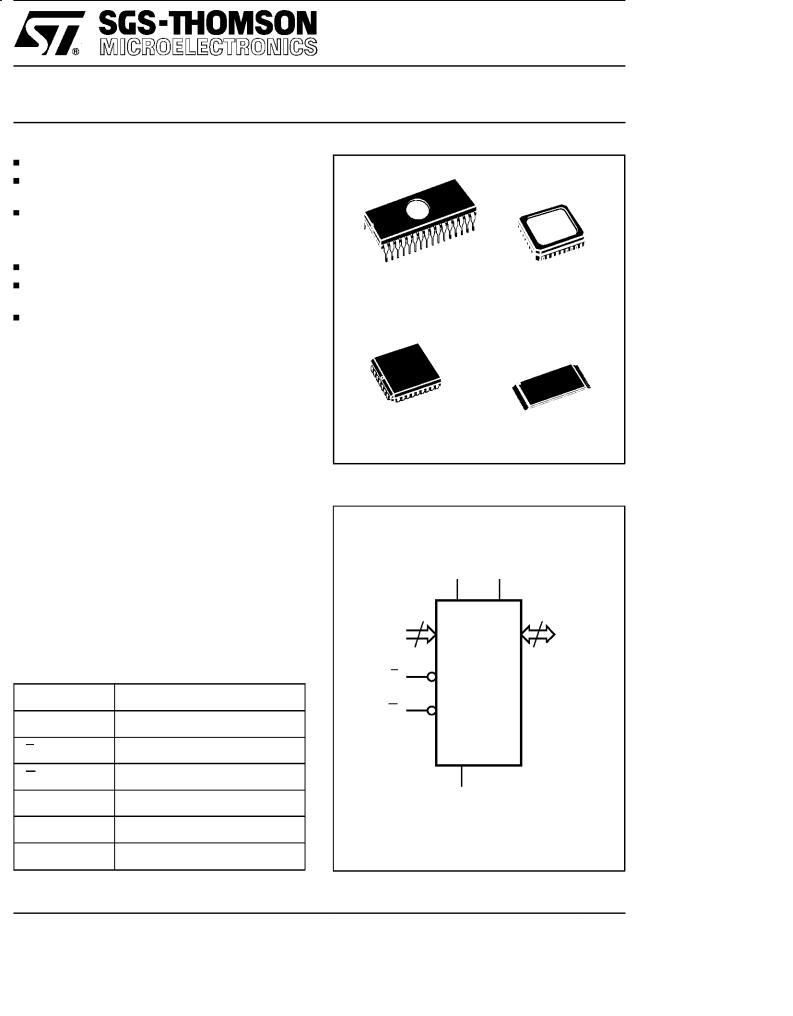
M27C4001
4 Megabit (512K x 8) UV EPROM and OTP ROM
VERY FAST ACCESS TIME: 70ns
COMPATIBLE with HIGH SPEED MICROPROCESSORS, ZERO WAIT STATE
LOW POWER ºCMOSº CONSUMPTION:
±Active Current 30mA at 5MHz
±Standby Current 100μA PROGRAMMING VOLTAGE: 12.75V
ELECTRONIC SIGNATURE for AUTOMATED PROGRAMMING
PROGRAMMING TIMES of AROUND 48sec. (PRESTO II ALGORITHM)
DESCRIPTION
The M27C4001 is a high speed 4 Megabit UV erasable and programmable memory (EPROM) ideally suited for microprocessor systems requiring large programs. It isorganised as 524,288 by 8 bits.
The 32 pin Window Ceramic Frit-Seal Dual-in-Line and Leadless Chip Carrier packages have transparent lids which allow the user to expose the chip to ultraviolet light to erase the bit pattern. A new pattern can then be written to the device by following the programming procedure.
For applications where the content is programmed only one time and erasure is not required, the M27C4001 is offered in both Plastic Leaded Chip Carrier and Plastic Thin Small Outline packages.
Table 1. Signal Names
A0 - A18 |
Address Inputs |
Q0 - Q7 |
Data Outputs |
E |
Chip Enable |
G |
Output Enable |
VPP |
Program Supply |
VCC |
Supply Voltage |
VSS |
Ground |
28
1
FDIP32W (F) |
LCCC32W (L) |
PLCC32 (C) |
TSOP32 (N) |
|
8 x 20mm |
Figure 1. Logic Diagram
VCC |
VPP |
19 |
8 |
A0-A18 |
Q0-Q7 |
E M27C4001
G
VSS
AI00721B
March 1995 |
1/14 |
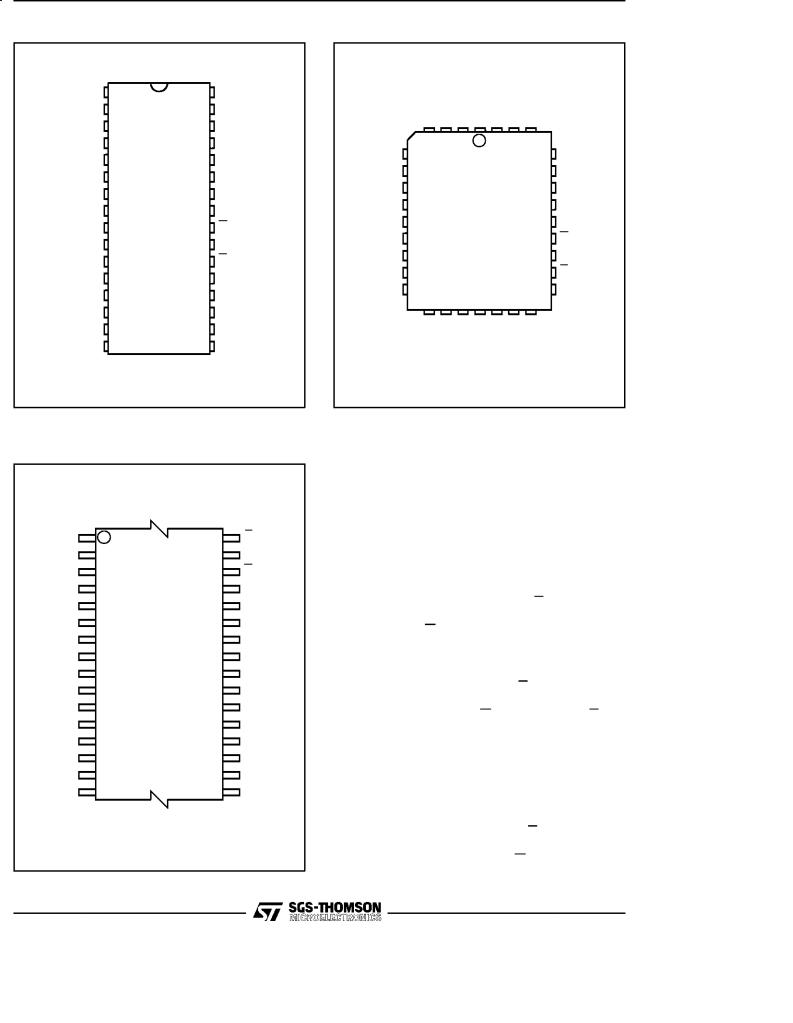
M27C4001
Figure 2A. DIP Pin Connections
VPP |
1 |
32 |
VCC |
A16 |
2 |
31 |
A18 |
A15 |
3 |
30 |
A17 |
A12 |
4 |
29 |
A14 |
A7 |
5 |
28 |
A13 |
A6 |
6 |
27 |
A8 |
A5 |
7 |
26 |
A9 |
A4 |
8 |
M27C4001 25 |
A11 |
A3 |
9 |
24 |
G |
A2 |
10 |
23 |
A10 |
A1 |
11 |
22 |
E |
A0 |
12 |
21 |
Q7 |
Q0 |
13 |
20 |
Q6 |
Q1 |
14 |
19 |
Q5 |
Q2 |
15 |
18 |
Q4 |
VSS |
16 |
17 |
Q3 |
|
|
AI00722 |
|
Figure 2B. LCC Pin Connections
|
A12 |
A15 |
A16 |
PP |
CC |
A18 |
A17 |
|
|
V |
V |
|
|||||
A7 |
|
|
|
1 |
32 |
|
|
A14 |
|
|
|
|
|
|
|
||
A6 |
|
|
|
|
|
|
|
A13 |
A5 |
|
|
|
|
|
|
|
A8 |
A4 |
|
|
|
|
|
|
|
A9 |
A3 |
9 |
|
M27C4001 |
|
25 |
A11 |
||
A2 |
|
|
|
|
|
|
|
G |
A1 |
|
|
|
|
|
|
|
A10 |
A0 |
|
|
|
|
|
|
|
E |
Q0 |
|
|
|
17 |
|
|
|
Q7 |
|
|
|
|
|
|
|
|
|
|
Q1 |
Q2 |
SS Q3 |
Q4 |
Q5 |
Q6 |
|
|
|
|
|
V |
|
|
|
|
|
AI00723
Figure 2C. TSOP Pin Connections
A11 |
1 |
|
32 |
G |
A9 |
|
|
|
A10 |
A8 |
|
|
|
E |
A13 |
|
|
|
Q7 |
A14 |
|
|
|
Q6 |
A17 |
|
|
|
Q5 |
A18 |
|
|
|
Q4 |
VCC |
8 |
M27C4001 |
25 |
Q3 |
VPP |
9 |
(Normal) |
24 |
VSS |
A16 |
|
|
|
Q2 |
A15 |
|
|
|
Q1 |
A12 |
|
|
|
Q0 |
A7 |
|
|
|
A0 |
A6 |
|
|
|
A1 |
A5 |
|
|
|
A2 |
A4 |
16 |
|
17 |
A3 |
|
|
AI01155B |
|
|
DEVICE OPERATION
The modes of operations of the M27C4001 are listed in the Operating Modes table. A single 5V power supply is required in the read mode. All inputs are TTL levels except for Vpp and 12V on A9 for Electronic Signature.
Read Mode
The M27C4001 has two control functions, both of which must be logically active in order to obtain data at the outputs. Chip Enable (E) is the power control and should be used for device selection. Output Enable (G) is the output control and should be used to gate data to the output pins, independent of device selection. Assuming that the addresses are stable, the address access time
(tAVQV) is equal to the delay from E to output (tELQV). Data is available at the output after a delay of tGLQV from the falling edge of G, assuming that E has been low and the addresses have been stable for at least tAVQV-tGLQV.
Standby Mode
The M27C4001 has a standby mode which reduces the active current from 30mA to 100μA. The M27C4001 is placed in the standby mode by applying a CMOS high signal to the E input. When in the standbymode, the outputs are in a high impedance state, independent of the G input.
2/14
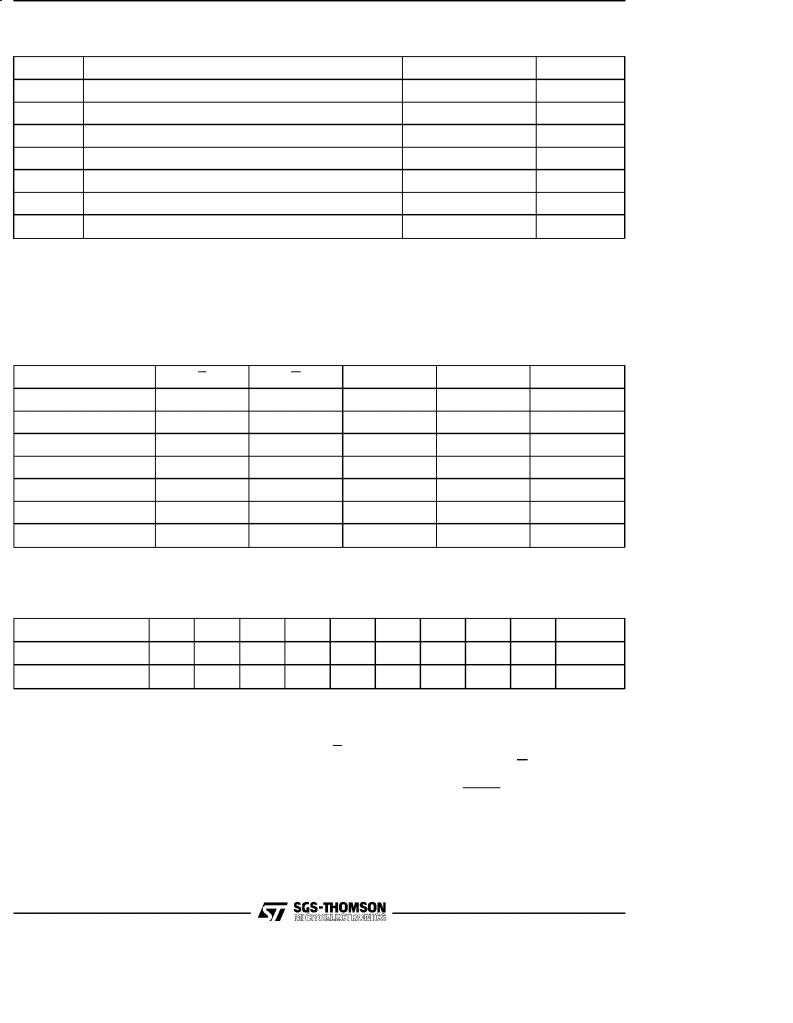
|
|
|
M27C4001 |
Table 2. Absolute Maximum Ratings (1) |
|
|
|
Symbol |
Parameter |
Value |
Unit |
TA |
Ambient Operating Temperature |
±40 to 125 |
°C |
TBIAS |
Temperature Under Bias |
±50 to 125 |
°C |
TSTG |
Storage Temperature |
±65 to 150 |
°C |
(2) |
Input or Output Voltages (except A9) |
±2 to 7 |
V |
VIO |
|||
VCC |
Supply Voltage |
±2 to 7 |
V |
(2) |
A9 Voltage |
±2 to 13.5 |
V |
VA9 |
|||
VPP |
Program Supply Voltage |
±2 to 14 |
V |
Notes: 1. Except for the rating ºOperating Temperature Rangeº, stresses above those listed in the Table ºAbsolute Maximum Ratingsº may cause permanent damage to the device. These are stress ratings only and operation of the device at these or any other conditions above those indicated in the Operating sections of this specification is not implied. Exposure to Absolute Maximum Rating conditions for extended periods may affect device reliability. Refer also to the SGS-THOMSON SURE Program and other relevant quality documents.
2.Minimum DC voltage on Input or Output is ±0.5V with possible undershoot to ±2.0V for a period less than 20ns. Maximum DC voltage on Output is VCC +0.5V with possible overshoot to VCC +2V for a period less than 20ns.
Table 3. Operating Modes
Mode |
E |
G |
A9 |
VPP |
Q0 - Q7 |
Read |
VIL |
VIL |
X |
VCC or VSS |
Data Out |
Output Disable |
VIL |
VIH |
X |
VCC or VSS |
Hi-Z |
Program |
VIL Pulse |
VIH |
X |
VPP |
Data In |
Verify |
VIH |
VIL |
X |
VPP |
Data Out |
Program Inhibit |
VIH |
VIH |
X |
VPP |
Hi-Z |
Standby |
VIH |
X |
X |
VCC or VSS |
Hi-Z |
Electronic Signature |
VIL |
VIL |
VID |
VCC |
Codes |
Note: X = VIH or VIL, VID = 12V ± 0.5V |
|
|
|
|
|
Table 4. Electronic Signature
Identifier |
A0 |
Q7 |
Q6 |
Q5 |
Q4 |
Q3 |
Q2 |
Q1 |
Q0 |
Hex Data |
Manufacturer's Code |
VIL |
0 |
0 |
1 |
0 |
0 |
0 |
0 |
0 |
20h |
Device Code |
VIH |
0 |
1 |
0 |
0 |
0 |
0 |
0 |
1 |
41h |
Two Line Output Control
Because EPROMs are usually used in larger memory arrays, this product features a 2 line control function which accommodates the use of multiple memory connection. The two line control function allows:
a.the lowest possible memory power dissipation,
b.complete assurance that output bus contention will not occur.
For the most efficient use of these two control lines, E should be decoded and used as the primary device selecting function, while G should be made a common connection to all devices in the array and connected to the READ line from the system control bus. This ensures that all deselected memory devices are in their low power standby mode and that the output pins are only active when data is required from a particular memory device.
3/14
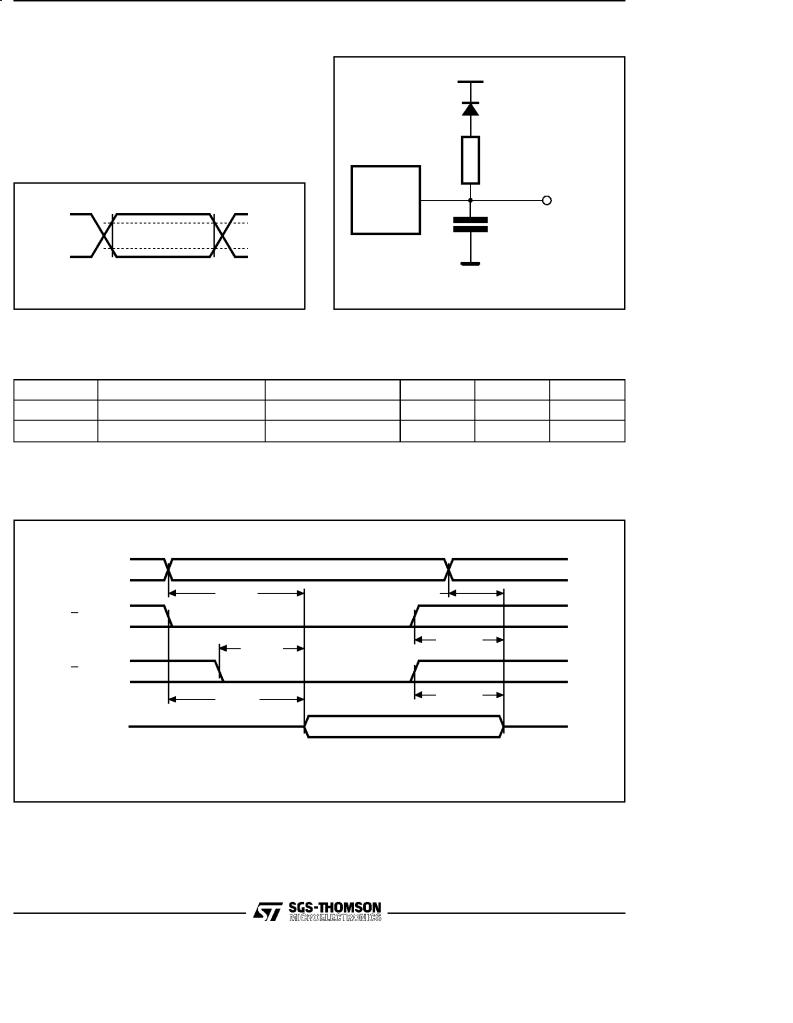
M27C4001
AC MEASUREMENT CONDITIONS
Input Rise and Fall Times |
≤ 20ns |
Input Pulse Voltages |
0.4V to 2.4V |
Input and Output Timing Ref. Voltages |
0.8V to 2.0V |
Note that Output Hi-Z is defined as the point where data is no longer driven.
Figure 3. AC Testing Input Output Waveforms
2.4V
2.0V
0.8V
0.4V
AI00826
Figure 4. AC Testing Load Circuit
1.3V
1N914
3.3kΩ
DEVICE
UNDER OUT TEST
CL = 100pF
CL includes JIG capacitance
AI00828
Table 5. Capacitance (1) (TA = 25 °C, f = 1 MHz )
Symbol |
Parameter |
Test Condition |
Min |
Max |
Unit |
CIN |
Input Capacitance |
VIN = 0V |
|
6 |
pF |
COUT |
Output Capacitance |
VOUT = 0V |
|
12 |
pF |
Note: 1. Sampled only, not 100% tested.
Figure 5. Read Mode AC Waveforms
A0-A18 |
VALID |
|
|
tAVQV |
tAXQX |
E |
|
tGLQV |
tEHQZ |
|
|
G |
|
tELQV |
tGHQZ |
|
|
Q0-Q7 |
Hi-Z |
DATA OUT |
|
|
AI00724 |
4/14
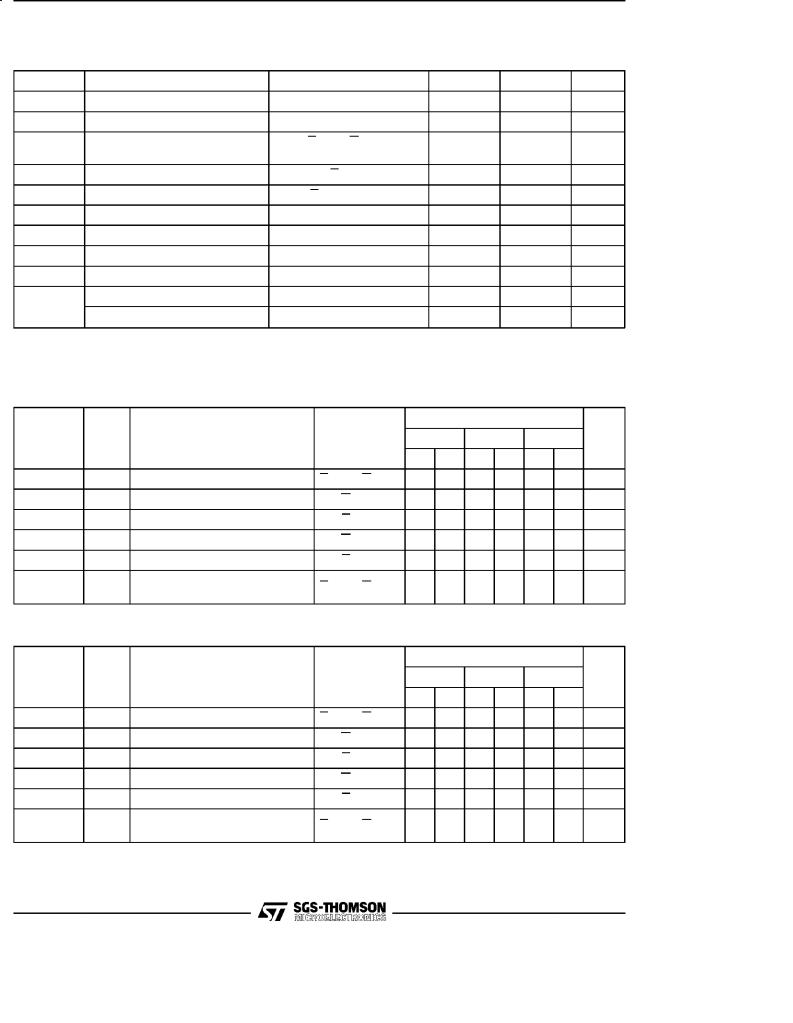
|
|
|
|
|
|
|
|
|
|
|
M27C4001 |
|
Table 6. Read Mode DC Characteristics (1) |
|
|
|
|
|
|
|
|
|
|
||
(TA = 0 to 70 °C or ±40 to 85 °C; VCC = 5V ± 5% or 5V ± 10%; VPP = VCC) |
|
|
|
|
|
|||||||
Symbol |
|
Parameter |
|
Test Condition |
|
Min |
|
Max |
|
Unit |
||
ILI |
Input Leakage Current |
|
|
0V ≤ VIN ≤ VCC |
|
|
|
|
±10 |
|
μA |
|
ILO |
Output Leakage Current |
|
0V ≤ VOUT ≤ VCC |
|
|
|
|
±10 |
|
μA |
||
ICC |
Supply Current |
|
E = VIL, G = VIL, |
|
|
|
|
30 |
|
mA |
||
IOUT = 0mA, f = 5MHz |
|
|
|
|
|
|||||||
|
|
|
|
|
|
|
|
|
|
|||
ICC1 |
Supply Current (Standby) TTL |
|
|
E = VIH |
|
|
|
|
1 |
|
mA |
|
ICC2 |
Supply Current (Standby) CMOS |
|
|
E > VCC ± 0.2V |
|
|
|
|
100 |
|
μA |
|
IPP |
Program Current |
|
|
VPP = VCC |
|
|
|
|
10 |
|
μA |
|
VIL |
Input Low Voltage |
|
|
|
|
±0.3 |
|
0.8 |
|
V |
||
(2) |
Input High Voltage |
|
|
|
|
2 |
|
VCC + 1 |
V |
|||
VIH |
|
|
|
|
|
|||||||
VOL |
Output Low Voltage |
|
|
IOL = 2.1mA |
|
|
|
|
0.4 |
|
V |
|
VOH |
Output High Voltage TTL |
|
|
IOH = ±400μA |
|
2.4 |
|
|
|
V |
||
Output High Voltage CMOS |
|
|
IOH = ±100μA |
|
VCC ± 0.7V |
|
|
|
V |
|||
|
|
|
|
|
|
|
||||||
Notes: 1. VCC must be applied simultaneously with or before VPP and removed simultaneously or after VPP. |
|
|
|
|
||||||||
2. Maximum DC voltage on Output is VCC +0.5V. |
|
|
|
|
|
|
|
|
|
|
||
Table 7A. Read Mode AC Characteristics (1) |
|
|
|
|
|
|
|
|
|
|
||
(TA = 0 to 70 °C or ±40 to 85 °C; VCC = 5V ± 5% or 5V ± 10%; VPP = VCC) |
|
|
|
|
|
|||||||
|
|
|
|
|
|
|
M27C4001 |
|
|
|
||
Symbol |
Alt |
Parameter |
|
|
Test Condition |
-70 |
-80 |
-90 |
Unit |
|||
|
|
|
|
|
|
|
||||||
|
|
|
|
|
|
Min |
Max |
Min |
Max |
Min |
Max |
|
tAVQV |
tACC |
Address Valid to Output Valid |
|
|
E = VIL, G = VIL |
|
70 |
|
80 |
|
90 |
ns |
tELQV |
tCE |
Chip Enable Low to Output Valid |
|
G = VIL |
|
70 |
|
80 |
|
90 |
ns |
|
tGLQV |
tOE Output Enable Low to Output Valid |
E = VIL |
|
35 |
|
40 |
|
40 |
ns |
|||
(2) |
tDF |
Chip Enable High to Output Hi-Z |
|
G = VIL |
0 |
30 |
0 |
30 |
0 |
30 |
ns |
|
tEHQZ |
|
|||||||||||
(2) |
tDF |
Output Enable High to Output Hi-Z |
E = VIL |
0 |
30 |
0 |
30 |
0 |
30 |
ns |
||
tGHQZ |
||||||||||||
tAXQX |
tOH |
Address Transition to |
|
|
E = VIL, G = VIL |
0 |
|
0 |
|
0 |
|
ns |
Output Transition |
|
|
|
|
|
|||||||
|
|
|
|
|
|
|
|
|
|
|
|
|
Table 7B. Read Mode AC Characteristics (1) |
|
|
|
|
|
|
|
|
|
|
||
(TA = 0 to 70 °C or ±40 to 85 °C; VCC = 5V ± 5% or 5V ± 10%; VPP = VCC) |
|
|
|
|
|
|||||||
|
|
|
|
|
|
|
M27C4001 |
|
|
|
||
Symbol |
Alt |
Parameter |
|
|
Test Condition |
-10 |
-12 |
-15 |
Unit |
|||
|
|
|
|
|
|
|
||||||
|
|
|
|
|
|
Min |
Max |
Min |
Max |
Min |
Max |
|
tAVQV |
tACC |
Address Valid to Output Valid |
|
|
E = VIL, G = VIL |
|
100 |
|
120 |
|
150 |
ns |
tELQV |
tCE |
Chip Enable Low to Output Valid |
|
G = VIL |
|
100 |
|
120 |
|
150 |
ns |
|
tGLQV |
tOE |
Output Enable Low to Output Valid |
E = VIL |
|
50 |
|
60 |
|
60 |
ns |
||
(2) |
tDF |
Chip Enable High to Output Hi-Z |
|
G = VIL |
0 |
30 |
0 |
40 |
0 |
50 |
ns |
|
tEHQZ |
|
|||||||||||
(2) |
tDF |
Output Enable High to Output Hi-Z |
E = VIL |
0 |
30 |
0 |
40 |
0 |
50 |
ns |
||
tGHQZ |
||||||||||||
tAXQX |
tOH |
Address Transition to |
|
|
E = VIL, G = VIL |
0 |
|
0 |
|
0 |
|
ns |
Output Transition |
|
|
|
|
|
|||||||
|
|
|
|
|
|
|
|
|
|
|
|
|
Notes: 1. VCC must be applied simultaneously with or before VPP and removed simultaneously or after VPP. 2. Sampled only, not 100% tested.
5/14

M27C4001
Table 8. Programming Mode DC Characteristics (1)
(TA = 25 °C; VCC = 6.25V ± 0.25V; VPP = 12.75V ± 0.25V)
Symbol |
Parameter |
Test Condition |
Min |
Max |
Unit |
ILI |
Input Leakage Current |
0 ≤ VIN ≤ VCC |
|
±10 |
μA |
ICC |
Supply Current |
|
|
50 |
mA |
IPP |
Program Current |
E = VIL |
|
50 |
mA |
VIL |
Input Low Voltage |
|
±0.3 |
0.8 |
V |
VIH |
Input High Voltage |
|
2 |
VCC + 0.5 |
V |
VOL |
Output Low Voltage |
IOL = 2.1mA |
|
0.4 |
V |
VOH |
Output High Voltage TTL |
IOH = ±400μA |
2.4 |
|
V |
VID |
A9 Voltage |
|
11.5 |
12.5 |
V |
Note: 1. VCC must be applied simultaneously with or before VPP and removed simultaneously or after VPP.
Table 9. Programming Mode AC Characteristics (1)
(TA = 25 °C; VCC = 6.25V ± 0.25V; VPP = 12.75V ± 0.25V)
Symbol Alt
tAVEL tAS
tQVEL tDS
tVPHEL tVPS
tVCHEL tVCS
tELEH tPW
tEHQX tDH
tQXGL tOES
tGLQV tOE
tGHQZ tDFP
tGHAX tAH
Parameter |
Test Condition |
Min |
Max |
Unit |
Address Valid to Chip Enable Low
Input Valid to Chip Enable Low
VPP High to Chip Enable Low
VCC High to Chip Enable Low
Chip Enable Program Pulse
Width
Chip Enable High to Input Transition
Input Transition to Output Enable Low
Output Enable Low to Output Valid
Output Enable High to Output Hi-Z
Output Enable High to Address Transition
2 |
|
μs |
2 |
|
μs |
2 |
|
μs |
2 |
|
μs |
95 |
105 |
μs |
2 |
|
μs |
2 |
|
μs |
|
100 |
ns |
0 |
130 |
ns |
0 |
|
ns |
Notes: 1. VCC must be applied simultaneously with or before VPP and removed simultaneously or after VPP. 2. Sampled only, not 100% tested.
6/14
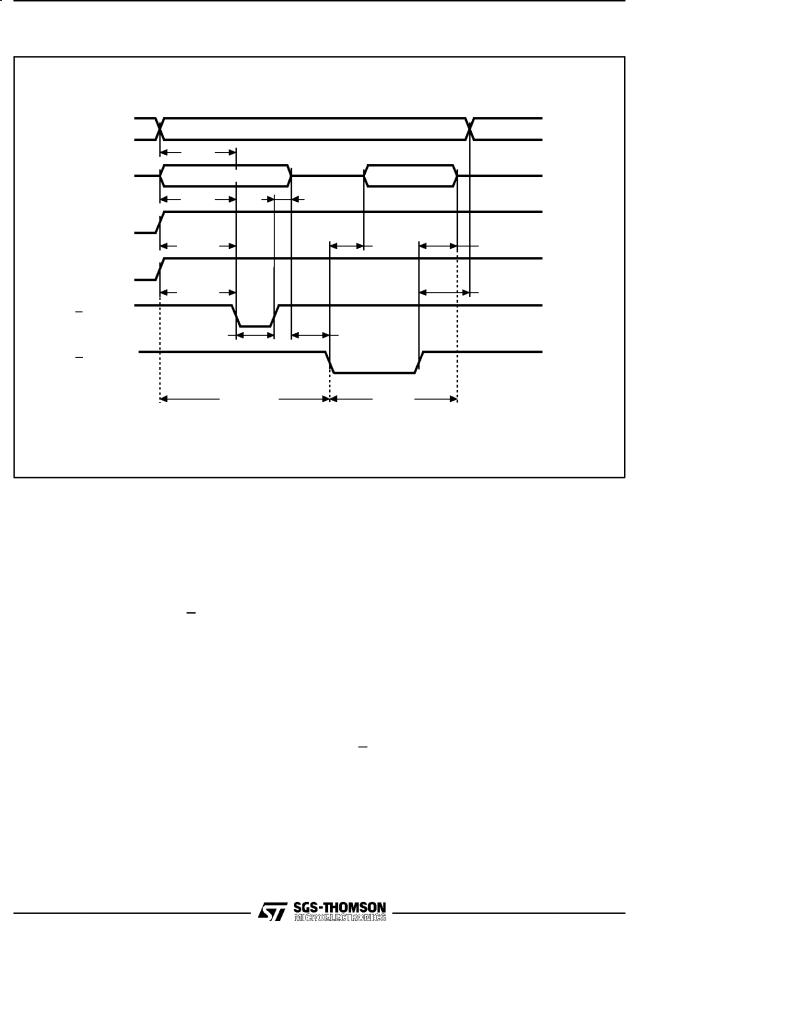
M27C4001
Figure 6. Programming and Verify Modes AC Waveforms
A0-A18 |
|
VALID |
|
|
|
|
|
|
tAVPL |
|
|
Q0-Q7 |
DATA IN |
DATA OUT |
|
|
tQVEL |
tEHQX |
|
VPP |
|
|
|
|
tVPHEL |
tGLQV |
tGHQZ |
VCC |
|
|
|
|
tVCHEL |
|
tGHAX |
E |
|
|
|
|
tELEH |
tQXGL |
|
G |
|
|
|
|
PROGRAM |
VERIFY |
|
|
|
|
AI00725 |
System Considerations
The power switching characteristics of Advanced CMOS EPROMs require careful decoupling of the devices. The supply current, ICC, has three segments that are of interest to the system designer : the standby current level, the active current level, and transient current peaks that are produced by the falling and rising edges of E. The magnitude of the transient current peaks is dependent on the capacitive and inductive loading of the device at the output.
The associated transient voltage peaks can be suppressed by complying with the two line output control and by properly selected decoupling capacitors. It is recommended that a 0.1μF ceramic capacitor be used on every device between VCC and VSS. This should be a high frequency capacitor of low inherent inductance and should be placed as close to the device as possible. In addition, a
4.7μF bulk electrolytic capacitor should be used between VCC and VSS for every eight devices. The bulk capacitor should be located near the power supply connection point.The purpose of the bulk capacitor is to overcome the voltage drop caused by the inductive effects of PCB traces.
Programming
When delivered (and after each erasure for UV EPROM), all bits of the M27C4001 are in the º1º state. Data is introduced by selectively programming º0sº into the desired bit locations. Although only º0sº will be programmed, both º1sº and º0sº can be present in the data word. The only way to change a º0º to a º1º is by die exposition to ultraviolet light (UV EPROM). The M27C4001 is in the programming mode when VPP input is at 12.75V, and E is at TTL-low. The data to be programmed is applied 8 bits in parallel to the data output pins. The levels required for the address and data inputs are TTL. VCC is specified to be 6.25V ± 0.25V.
7/14
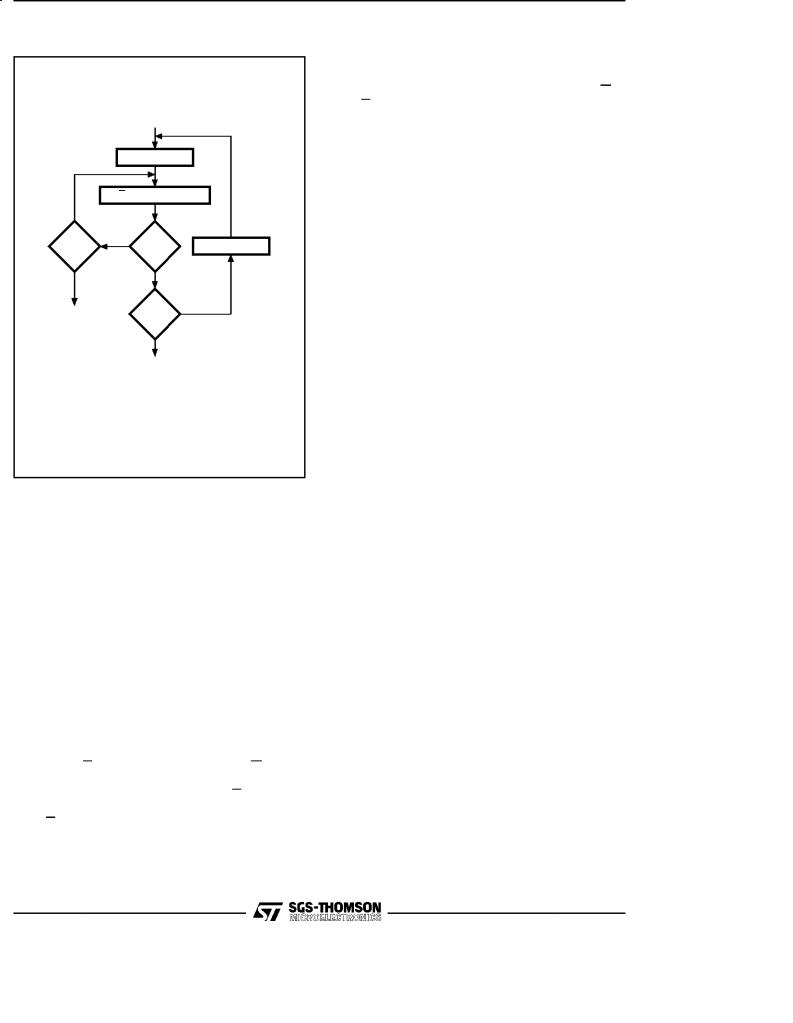
M27C4001
Figure 7. Programming Flowchart
|
VCC = 6.25V, VPP = 12.75V |
|
|
n = 0 |
|
|
E = 100μs Pulse |
|
NO |
|
|
++n |
NO |
++ Addr |
= 25 |
VERIFY |
|
|
|
|
YES |
YES |
|
FAIL |
Last |
NO |
Addr |
|
|
|
|
|
YES
CHECK ALL BYTES 1st: VCC = 6V 2nd: VCC = 4.2V
AI00760B
PRESTO II Programming Algorithm
PRESTO II Programming Algorithm allows the whole array to be programmed with a guaranteed margin, in a typical time of 52.5 seconds. Programming with PRESTO II consists of applying a sequence of 100μs program pulses to each byte until a correct verify occurs. During programming and verify operation, a MARGIN MODE circuit is automatically activated in order to guarantee that each cell is programmed with enough margin. No overprogram pulse is applied since the verify in MARGIN MODE provides the necessary margin to each programmed cell.
Program Inhibit
Programming of multiple M27C4001s in parallel with different data is also easily accomplished. Except for E, all like inputs including G of the parallel M27C4001 may be common. A TTL low level pulse applied to a M27C4001's E input, with VPP at 12.75V, will program that M27C4001. A high level E input inhibits the other M27C4001s from being programmed.
Program Verify
A verify (read) should be performed on the programmed bits to determine that they were correctly programmed. The verify is accomplished with G at VIL , E at VIH, VPP at 12.75V and VCC at 6.25V.
Electronic Signature
The Electronic Signature mode allows the reading out of a binary code from an EPROM that will identify its manufacturer and type. this mode is intended for use by programming equipment to automatically match the device to be programmed with its corresponding programming algorithm. This mode is functional in the 25°C ± 5°C ambient temperature range that is required when programming the M27C4001. To activate this mode, the programming equipmentmust force 11.5Vto 12.5V on address line A9 of the M27C4001 with VPP=VCC=5V. Two identifier bytes may then be sequenced from the device outputs by toggling address line A0 from VIL to VIH. All other address lines must be held at VIL during Electronic Signature mode. Byte 0 (A0=VIL) represents the manufacturer code and byte 1 (A0=VIH) the device id en t ifie r co de . For th e S GS-THOMSO N M27C4001, these two identifier bytes are given in Table 4 and can be read-out on outputs Q0 to Q7.
ERASURE OPERATION (applies to UV EPROM)
The erasure characteristics of the M27C4001 are such that erasure begins when the cells are exposed to light with wavelengths shorter than approximately 4000 Å. It should be noted that sunlight and some type of fluorescent lamps have wavelengths in the 3000-4000Å range. Data shows that constant exposure to room level fluorescent lighting could erase a typical M27C4001 in about 3 years, while it would take approximately 1 week to cause erasure when exposed to direct sunlight. If the M27C4001 is to be exposed to these types of lighting conditions for extended periods of time, it is suggested that opaque labels be put over the M27C4001 window to prevent unintentional erasure. The recommended erasure procedure for the M27C4001 is exposure to short wave ultraviolet light which has wavelength of 2537 Å. The integrated dose (i.e. UV intensity x exposure time) for erasure should be a minimum of 15 W-sec/cm2. The erasure time with this dosage is approximately 15 to 20 minutes using an ultraviolet lamp with 12000 μW/cm2 power rating. The M27C4001 should be placed within 2.5 cm (1 inch) of the lamp tubes during the erasure. Some lamps have a filter on their tubes which should be removed before erasure.
8/14

M27C4001
ORDERING INFORMATION SCHEME
Example: M27C4001 -80 X F 1 X
|
Speed |
VCC Tolerance |
|
Package |
Temperature Range |
|
Option |
|||
-70 |
70 ns |
X |
± 5% |
F |
FDIP32W |
1 |
0 to 70 °C |
X |
Additional |
|
-80 |
80 ns |
blank |
± 10% |
L |
LCCC32W |
6 |
±40 to 85 °C |
|
Burn-in |
|
TR |
Tape & Reel |
|||||||||
-90 |
90 ns |
|
|
C |
PLCC32 |
|
|
|||
|
|
|
|
|
Packing |
|||||
|
|
|
|
|
|
|
|
|
||
-10 |
100 ns |
|
|
N |
TSOP32 |
|
|
|
|
|
-12 |
120 ns |
|
|
|
8 x 20mm |
|
|
|
|
|
|
|
|
|
|
|
|
|
|||
-15 |
150 ns |
|
|
|
|
|
|
|
|
|
For a list of available options (Speed, VCC Tolerance, Package, etc...) refer to the current Memory Shortform catalogue.
For further information on any aspect of this device, please contact SGS-THOMSON Sales Office nearest to you.
9/14
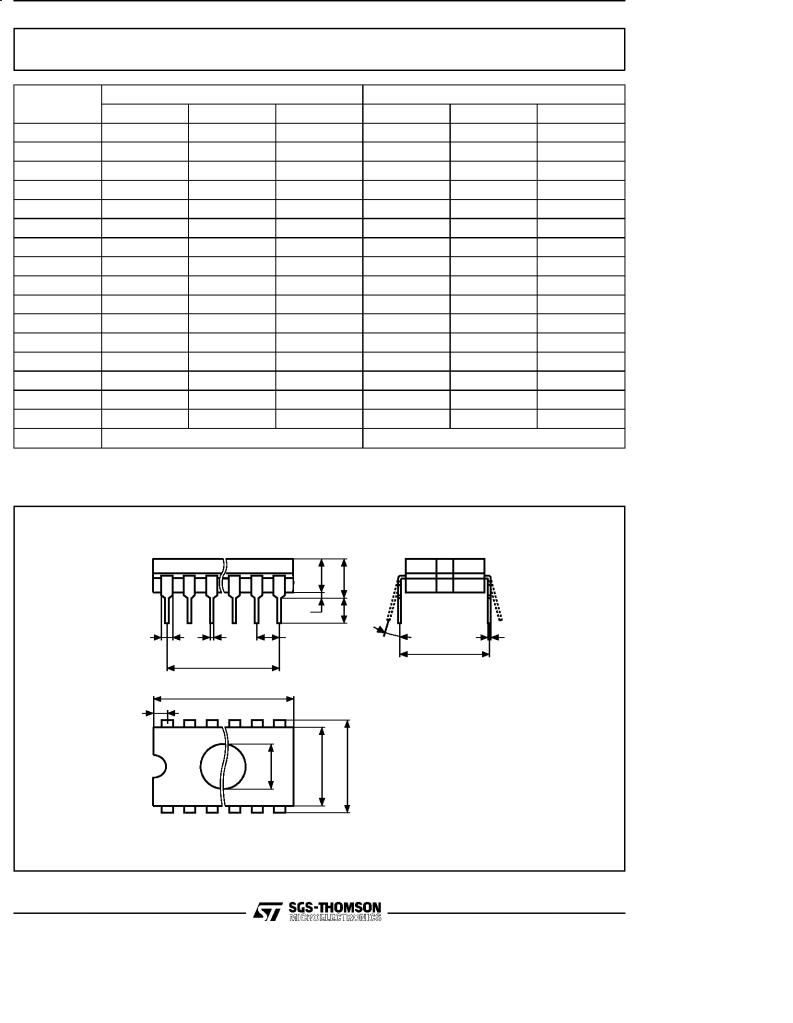
M27C4001
FDIP32W - 32 pin Ceramic Frit-seal DIP, with window
Symb |
|
mm |
|
|
inches |
|
|
Typ |
Min |
Max |
Typ |
Min |
Max |
||
|
|||||||
A |
|
|
5.71 |
|
|
0.225 |
|
A1 |
|
0.50 |
1.78 |
|
0.020 |
0.070 |
|
A2 |
|
3.90 |
5.08 |
|
0.154 |
0.200 |
|
B |
|
0.40 |
0.55 |
|
0.016 |
0.022 |
|
B1 |
|
1.27 |
1.52 |
|
0.050 |
0.060 |
|
C |
|
0.22 |
0.31 |
|
0.009 |
0.012 |
|
D |
|
|
42.78 |
|
|
1.684 |
|
E |
|
15.40 |
15.80 |
|
0.606 |
0.622 |
|
E1 |
|
14.50 |
14.90 |
|
0.571 |
0.587 |
|
e1 |
2.54 |
± |
± |
0.100 |
± |
± |
|
e3 |
38.10 |
± |
± |
1.500 |
± |
± |
|
eA |
|
16.17 |
18.32 |
|
0.637 |
0.721 |
|
L |
|
3.18 |
4.10 |
|
0.125 |
0.161 |
|
S |
|
1.52 |
2.49 |
|
0.060 |
0.098 |
|
|
9.65 |
± |
± |
0.380 |
± |
± |
|
α |
|
4° |
15° |
|
4° |
15° |
|
N |
|
32 |
|
|
32 |
|
FDIP32W
|
|
A2 |
A |
|
|
|
A1 |
L |
|
B1 |
B |
e1 |
α |
C |
|
e3 |
|
|
eA |
|
|
|
|
|
|
D |
|
|
|
|
S |
|
|
|
|
N |
|
|
|
|
|
E1 |
E |
|
|
1 |
|
|
|
FDIPW-a
Drawing is not to scale
10/14
